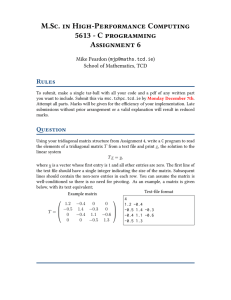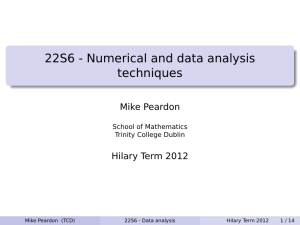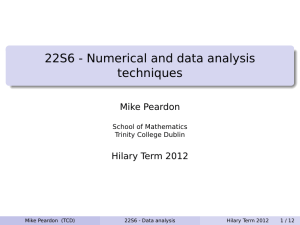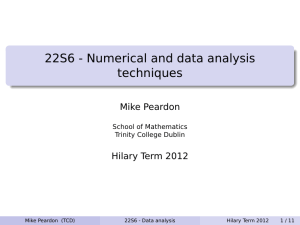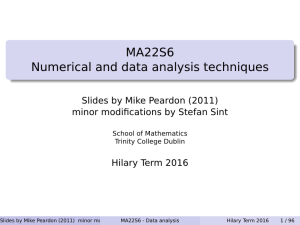22S6 - Numerical and data analysis techniques Mike Peardon Hilary Term 2012
advertisement
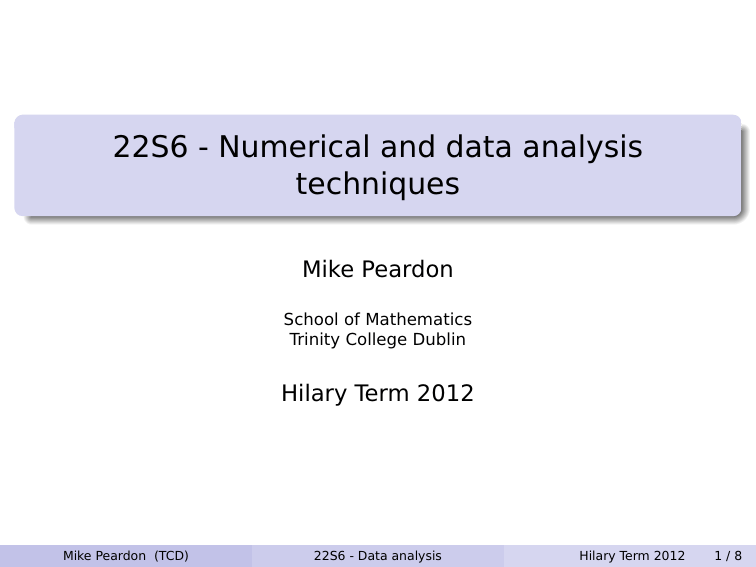
22S6 - Numerical and data analysis
techniques
Mike Peardon
School of Mathematics
Trinity College Dublin
Hilary Term 2012
Mike Peardon (TCD)
22S6 - Data analysis
Hilary Term 2012
1/8
Poisson processes
Mike Peardon (TCD)
22S6 - Data analysis
Hilary Term 2012
2/8
What is a poisson process?
The poisson process describes the behaviour of simple
stochastic systems where events happen in a memoryless
way. ie
The probability of an event occuring in a particular time
interval is independent of the occurence of events in the
past or the future.
The probability of one event occuring in a small time
interval, dt is defined to be λdt + O(dt 2 ), where λ is a
constant and λdt 1.
The probability of more than one event occuring in the
interval dt vanishes like O(dt n ), n ≥ 2 as dt → 0.
The last two conditions imply the probability there are no
events in the small interval is (1 − λdt) + O(dt 2 ).
Mike Peardon (TCD)
22S6 - Data analysis
Hilary Term 2012
3/8
Probability of no events in a finite interval
Now let us compute Q0 (t), the probability no events occur in a
finite interval of length t. Since the Poisson process is
memoryless, this can be computed easily as the product of
independent probabilities, so as dt → 0,
Q0 (t + dt) = Q0 (t) × (1 − λdt)
and this leads to a simple differential equation for Q0 ,
dQ0
= λQ0
dt
⇒ Q0 (t) = Ce−λt
The constant C is determined by noting the probability there
are no arrivals in a vanishingly small interval is 1, so C = 1 and
Q0 (t) = e−λt
Mike Peardon (TCD)
22S6 - Data analysis
Hilary Term 2012
4/8
Probability of one event in a finite interval
t
start
+
There are two mutually exclusive
ways for a single event to have occured in the interval [0, t + dt].
dt
One event occurs in [0, t] and
no event occurs in [t, t + dt]
Q0 (t)
x
λ dt
Q1 (t)
x
1− λ dt
No event occurs in [0, t] and
one event occurs in [t, t + dt]
Q1 (t + dt) = Q0 (t) × λdt + Q1 (t) × (1 − λdt)
and this leads to another differential equation for Q1 ,
dQ1
+ λQ1 = λQ0
dt
and given Q0 and with the condition that Q1 (0) = 0 gives
Q1 (t) = λte−λt
Mike Peardon (TCD)
22S6 - Data analysis
Hilary Term 2012
5/8
Probability of k event in a finite interval
The same reasoning gives a differential equation for Qk in
terms of Qk and Qk−1 ,
dQk
dt
= λ(Qk−1 − Qk )
and so Qk can be deduced for k = 2, 3, 4, . . . . A pattern quickly
emerges, and it can be shown by induction that
Qk (t) =
(λt)k e−λt
k!
It
follows that these probabilities are properly normalised ie
P∞
Q (t) = 1, and also that
k=0 k
∞
X
E(k) =
kQk (t) = λt
k=0
ie. the expected number of events in an interval t is just λt.
Mike Peardon (TCD)
22S6 - Data analysis
Hilary Term 2012
6/8
Intervals between events (1)
Event 0
1
T1
2
T2
3
T3
4
T4
If we measure the times between adjacent events, the
resulting sequence consists of a set of stochastic
variables.
{T1 , T2 , T3 , T4 , . . . }
Since the poisson process is memoryless, they will all be
drawn from the same underlying probability distribution.
What is this distribution?
After event 0 occurs, consider the probability event 1
does not occur in a subsequent time t. This means T1 > t,
and so P(T1 > t) = Q0 (t) = e−λt
Mike Peardon (TCD)
22S6 - Data analysis
Hilary Term 2012
7/8
Intervals between events (2)
As a result, P(T1 ≤ t) = 1 − e−λt
This is the cumulative probability distribution for T1 (and
consequently all T), and so the probability density of T is
given by
fT (t) =
d
1 − e−λt = λe−λt
dt
The inter-event times of a Poisson process are
exponentially distributed.
The Poisson process is an example of a continuous-time
Markov process.
Mike Peardon (TCD)
22S6 - Data analysis
Hilary Term 2012
8/8


